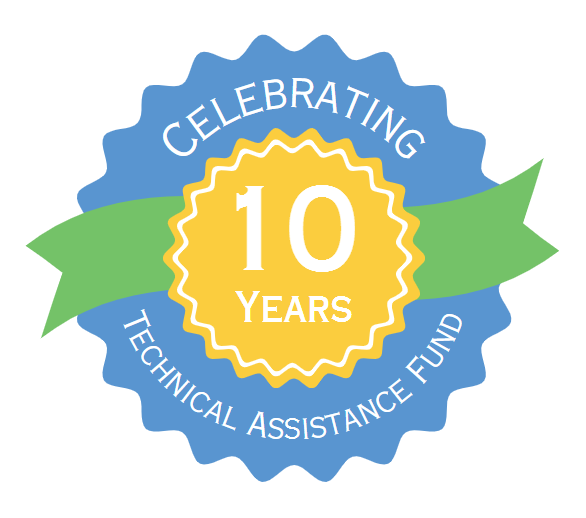June 26, 2024
Centering Equity in Data Collection: CEG’s Resilient Power Funding Programs
By Abbe Ramanan

This blog is part of a series celebrating 10 years of Clean Energy Group’s Technical Assistance Fund, which provides small grants to community-serving organizations pursuing resilient power. To learn more about the TAF and read other blogs in the series, click here.
This year marks 10 years since Clean Energy Group established its small grant programs, the Technical Assistance Fund (TAF) and Resilient Power Leadership Initiative (RPLI), to support the advancement of clean, resilient power technologies, like solar combined with energy storage, in historically marginalized communities. Over this past decade, the TAF and RPLI have evolved in response to a shifting economic and policy landscape, as well as growing demand for reliable, renewable, and local clean energy resources. In that time, CEG has also prioritized program outreach to critical service providers and grassroots organizations serving the communities most vulnerable to extreme weather and power outages, which often have capacity-restraints that make applying to grant programs prohibitive. The result is a larger, more inclusive program. In the first year of the TAF, for instance, CEG distributed five awards. In 2023, CEG distributed 49 awards (see maps below). CEG’s data collection methods have evolved alongside programmatic growth, but our commitment to equity, and ensuring we are meeting our equity-specific goals, is the driving force behind the metrics we track.

CEG’s Commitment to Equity
The TAF addresses a critical resource gap in resilient power development: funding for pre-development analyses of resilient power systems – solar paired with battery storage (solar+storage) – for organizations serving historically marginalized communities, including low-income communities, environmental justice communities, and communities of color. These communities are burdened with the worst impacts of climate change, including increased flooding, dangerously high heat, and chronic health problems due to pollution, and are also more likely to experience more frequent and prolonged power outages. Solar+storage can play a valuable role in providing clean, reliable backup power to facilities that can operate as resilience hubs during these outages.
However, community-serving institutions in these areas often have limited staff capacity to apply for funding or manage large grants, which is why the TAF was designed as a small grant program with a low barrier to entry and minimal reporting requirements. For this reason, the initial intake survey has been kept short at 20 straight-forward questions that do not require specialized knowledge to complete, such as the address of the facility, the number of residents or community members served by the facility, and the baseline level of knowledge of solar+storage applicants have. This last question helps CEG understand what resources or support the awardee might find most useful while going through the development process.
Prioritizing Black, Indigenous, and People of Color (BIPOC) Led Organizations
In 2020, CEG made a commitment to award 50 percent of TAF grants and 100 percent of RPLI grants to Black, Indigenous, and people of color (BIPOC)-led organizations. In years prior to this commitment (2014-2019), only 25 percent of TAFs were awarded to BIPOC-led organizations. In 2023, this figure increased to 41 percent. So far in 2024, 67 percent of funds awarded have been to BIPOC-led organizations, making this the first year we may meet or exceed our goal. Tracking this figure over time has played a valuable role in keeping CEG accountable to our commitment. In years when CEG fell short of meeting the 50 percent figure, the TAF team recalibrated, emphasizing the development of new partnerships with Tribal Nations, minority-owned engineers, and other institutions that could help bring the TAF to populations who might not have otherwise heard of the program. Importantly, CEG does not determine if an organization is BIPOC-led. Potential awardees are asked if their consider their organization identifies as BIPOC-led in the intake survey.
This tracking has also been valuable as interest in the TAF has grown. This year was the first that CEG did not have enough funding to cover the number of awards requested. In order to ensure funding was available for BIPOC partners, CEG set aside 50 percent of available funds for BIPOC-led organizations, many of which may have limited staff capacity to apply for funds quickly, to ensure these organizations were not inadvertently penalized for applying for a TAF later in the year.
Exit Surveys and Post-TAF Tracking
Since TAF awards cover the pre-development portion of a solar+storage project, much of CEG’s relationship with the awardee organization, and subsequent tracking of project metrics, takes place after the initial feasibility analysis has been completed. Awardees are asked to complete a brief exit survey following the completion of a feasibility analysis. This survey is meant to assess awardees experiences with both CEG and the third-party engineer, as well as how awardees’ understanding of solar+storage was impacted by going through the TAF process.
Beyond this initial exit survey however, CEG continues to check in with awardees through the entire project development cycle. Some solar+storage projects can take years to complete, so these relationships can provide invaluable data on obstacles to project development, or how major policy shifts, such as the ITC and Low-Income Communities Bonus Credits, can impact project outcomes. Because projects can take so long to develop, this data is often much harder to collect – points of contact at awardee organizations can move on, or the project might be shelved for several years until the organization has more capacity to pursue solar+storage.
As the TAF has grown over time, streamlining program processes to measure these post-TAF impacts, particularly if the project does eventually get installed, has become a priority for the CEG team. Data collection at this level has been invaluable for understanding the TAF’s impact: a recent survey of TAF recipients found that awardees were able to use their assessments to activate nearly $18 million in outside capital to install 32 projects totaling 6 megawatts of solar capacity and 4 megawatt-hours of battery storage capacity.
Looking Ahead
The need for early-stage, accessible funding like the TAF will only continue to grow as low-income communities and communities of color look to take advantage of bigger federal grant opportunities like Solar for All and the Environmental and Climate Justice Community Change Grants. Thankfully, the need for TA support like the TAF is being prioritized in these larger project development programs. For instance, CEG, along with its partners in the Community Power Coalition, is one of 60 Solar for All selectees. The Community Power Coalition, led by Inclusive Prosperity Capital (IPC), is focused on increasing capacity and deployment of mission-driven, community-based solar developers. In this capacity, CEG will provide technical assistance related to deploying community solar paired with battery storage, relying on much of the same infrastructure we’ve developed for the TAF. Maintaining robust data collection and monitoring is a vital tool in ensuring that we keep our commitment to serving the most marginalized organizations and communities even while scaling up this program.














